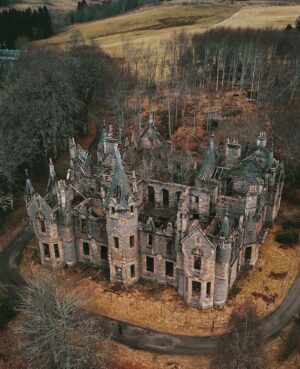Hugh Tennent is a man intrinsically linked with Glasgow. He took over his family’s beer firm in 1884 and one year later, after a trip to Germany to see how they brewed their booze, launched Tennent’s Lager.
The brand is still one of Scotland’s best known and best loved products and is recognisable the world over. It has always been produced at Wellpark Brewery, just east of the city centre, and brewing at the site dates back to Hugh’s great-great-grandfather (also Hugh) in 1740.
But although he died in Glasgow’s west end and is buried in the necropolis facing Wellpark, Hugh didn’t only live in the city. As a teenager, he bought Dunalastair House in Perthshire.
Part of a historic estate between Loch Rannoch and Loch Tummel, east of Pitlochry, the incredible castle is now abandoned but still cuts an imposing figure as it emerges from the surrounding forest like a ghost from the past.
Closer inspection shows the former stately home is now merely a skeletal ruin and a haven for urban explorers. But despite its dilapidated state, the building maintains many of its original external features, including its conical roofs, chimneys and even a coat of arms above the main entrance.
So what came to pass to see this impressive mansion with views of Schiehallion become a fairy tale ruin?
To view this content, you’ll need to update your privacy settings.
This two-storey Baronial manor was constructed on the site of two previous grand homes and was designed by Andrew Heiton, the architect behind many prestigious buildings in Perthshire and the surrounding areas.
Another house, originally owned by Jacobite chieftain Alexander Robertson of Struan, stood on the site. After being destroyed by fire following the 1745 uprising, it was replaced by a second mansion known as Mount Alexander.
In the early 1850s, the estate was sold by the then Clan Donnachaidh Chief, George Duncan Robertson, to General Sir John Macdonald of Dalchosnie.

Sir John, who commanded the land forces in Scotland, demolished Mount Alexander and replaced it with Dunalastair House in 1859. The MacDonald Clan Crest and the slogan Per Mare, Per Terras (By sea and land) can still be seen above the main entrance.
This is where Hugh Tennent comes into the picture, purchasing the house from Sir John’s son Alastair in 1881. Although Hugh accomplished much and his legacy lives on today, he tragically died in 1890 aged just 27.
He still owned Dunalastair House when he passed away and the following year it, along with the surrounding estate, was found new ownership in the hands of James Clark Bunten, then Chairman of the Caledonian Railway Company.
Ironically labelled as “neither a castle, nor comfortable family home”, Dunalastair’s deterioration began during World War I, as staffing for such an opulent residence dwindled. Dunalastair was next requisitioned during World War II to serve as a sanctuary school for the children of Polish refugees.
Tragically struck by fire in the late 1940s, it is rumoured that one casualty of the inferno was a piece of art by admired painter John Everett Millais. From the 1950s onwards, the mansion continued on its downward trajectory, as its furnishings were sold off and it was left empty.

Left to decay, the building succumbed to vandalism, including the theft of lead from its rooftops. And so it stands today, owned by James Clark Bunten’s great-grandson, Ian Cameron de Sales La Terrière, who lives one the estate with his wife, Rose.
Nestled by the banks of Dunalastair Water, the once illustrious building has caught the eye of several interested parties with plans for restoration. However, none have met the exacting tastes of the current owner, who has insisted they do not want the mansion to be demolished.
